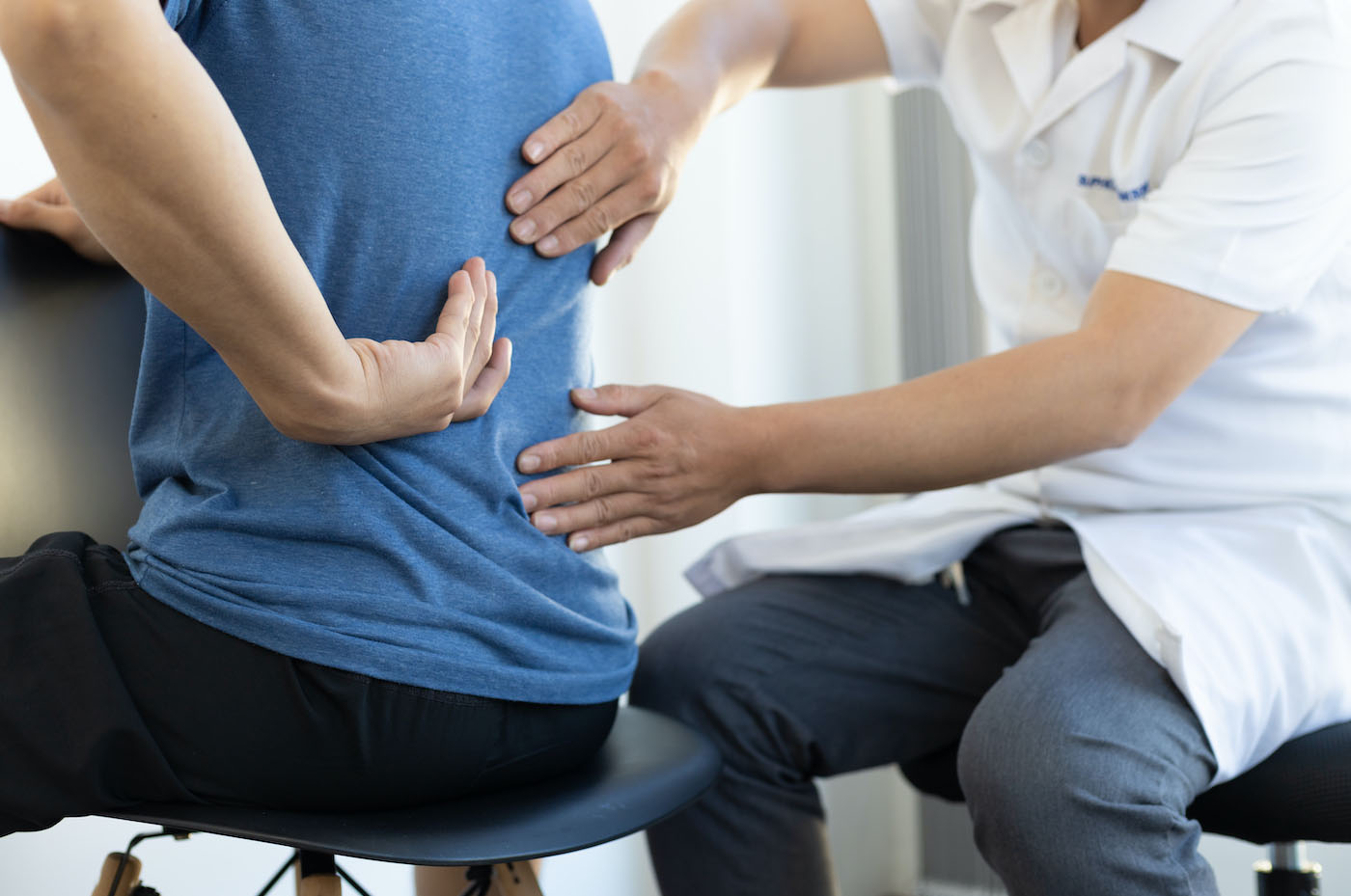Pediatric scoliosis is a spinal condition that occurs before the spine has matured when a child’s spine abnormally curves sideways or rotates. This is a fairly common spinal deformity with two to three percent of adolescents ages 10-18 presenting some form of scoliosis. While this starts as a cosmetic issue for most teens, severe scoliosis can cause a significant amount of pain and limit their ability to move. Scoliosis can also cause mental and emotional stress in teens because their looks and lifestyles are affected.
One of the best ways to prevent severe scoliosis is to detect it early on. If parents are aware of the condition and doctors can help families during the early stages of development, then most kids can grow into healthy teens with straighter spines. Learn more about pediatric scoliosis and what the treatment options look like.
What is Pediatric Scoliosis?
For most people, the spine runs straight up and down your back. It allows you to bend, twist, and move freely. However, there are times when it can start to curve to the right or the left, which changes how you walk and stand. This unexpected curvature can also be painful and limit your range of motion. The medical term for this condition is scoliosis.
Pediatric scoliosis occurs in young children and early teens (tweens) and is one of the most common forms of scoliosis. As kids grow, so do their bones. It is possible that the spine can start to grow in a curved formation as the bones develop and settle into place. By catching scoliosis early on, doctors can work to realign the spine before the bones are fully developed and the patient reaches adulthood.
The most common form of scoliosis is idiopathic scoliosis, which means it occurs without a known cause or reason. The patient is otherwise healthy and hitting their developmental milestones except that their spine has started to curve. Other types of scoliosis may occur in children with existing neuromuscular and genetic conditions.
Risk Factors for Pediatric Scoliosis
Pediatric scoliosis can present in almost any child or teenager, even if they haven’t shown signs of skeletal developmental problems before. This condition often presents during growth spurts (usually when kids are going through puberty). The body is growing quickly, especially the bones in the spine, which make them easier to see. The high visibility of the spine in the early teenage years makes it ideal for identifying scoliosis.
Girls are more likely to develop scoliosis than boys and this condition can be spread through genetics. If someone in your family lives with scoliosis or was treated for it as a child, your children are more likely to develop this condition.
Other risk factors include congenital abnormalities and neuromuscular disorders that affect development as a whole. If your child has an illness where they have poorly-formed bones or conditions like cerebral palsy, spina bifida, and muscular dystrophy, your doctor might be on the lookout to identify and treat signs of pediatric scoliosis.
Signs and Symptoms of Scoliosis in Children
There is good news for parents who are worried about pediatric scoliosis: this condition is fairly easy to diagnose. Many of the symptoms are visible to the trained eye in the early stages and will become more visible as the condition progresses. Here are a few signs to look for:
Abnormal Spine Curvature: the spine will usually bend to the left or the right.
Shoulder and Hip Asymmetry: parents might notice that one shoulder rests higher than the other. There could also be a noticeably uneven waist.
Back Pain: the patient might have a hard time moving or resting comfortably.
Breathing Difficulties: scoliosis can start to affect the lungs and airways of patients, making breathing painful.
Head not centered over the body: the head might tilt to the left or right.
Consider how your body looks when you rest your weight on one leg. Your hip sticks out and your body leans in the opposite direction for balance. This is what a prominent case of scoliosis can look like when a patient is standing evenly on both legs.
Diagnosis of Pediatric Scoliosis
A scoliosis diagnosis starts with a basic exam, which your general practitioner might conduct during your child’s annual check-up. Some districts even conduct school-wide scoliosis testing in students to catch this condition early on. The patient will bend forward slightly and the doctor can see if the spine is developing in a straight line.
If your doctor is worried about scoliosis, they might request additional tests and exams to better understand the patient’s health. The doctor might physically test for abnormal reflexes or muscle weakness and eventually could order a series of imaging tests.
Depending on the patient, the doctor might order an X-ray, MRI, or CT scan to better understand the changes in the spine. An X-ray is the easiest tool for a diagnosis, but your doctor may recommend an MRI if they are worried about other spinal cord abnormalities.
Treatment Options for Pediatric Scoliosis
The recommended treatment for pediatric scoliosis will depend on the patient and the severity of the condition. If a doctor is able to intervene early, they might be able to recommend non-invasive treatment options that help the spine grow straight and restore the health of the patient.
The first step toward any form of scoliosis treatment is observation and monitoring. The doctor wants to see if the condition is getting worse – and at what speed. If the spine is slightly curved and remains in place, there is usually time to work through multiple forms of intervention. However, if the curvature gets worse within a few months, it might be necessary to take action and correct the spine immediately.
Even after your teen completes their scoliosis treatment, your doctor might request follow-up appointments to monitor their spine until they reach adulthood.
Bracing for Pediatric Scoliosis
One of the most common treatment methods for pediatric scoliosis is the use of braces. A brace looks like a firm jacket that is meant to keep the spine in place and eventually straighten it out.
There are multiple types of braces (also called orthosis) that are meant to help kids and teens. Your doctor will work with you to identify which brace will be most effective and which one your child will most likely wear. After all, they will need to wear the brace at all times – unless they are showering or sleeping.
Braces are used for moderate scoliosis cases. They might not be needed if the case is too mild and they might not be effective if the curve is already too large. While this is a non-invasive treatment option, the biggest risk is if a child or teen is not wearing it. Their scoliosis could get worse because the unworn brace isn’t providing support.
Surgery Options
If the scoliosis is progressing rapidly or is severe enough that bracing will not work, your doctor may recommend surgical intervention. There are multiple types of surgery that can treat scoliosis. The first is spinal fusion. With this operation, your doctor will fuse the vertebrae in place so they form a straight line. This significantly reduces the curvature.
Depending on the patient, your doctor might recommend a Mehta cast, which is placed in the operating room. This works like a more advanced brace and will be replaced every few months as the child grows and the spine straightens. Finally, your doctor might be able to use magnetic growing rods that straighten the spine. The rods grow along with your child so they don’t need to be replaced.
Physical Therapy
Another potential treatment option for pediatric scoliosis is physical therapy. The goal of this strategy is to help your child learn how to stretch and move their body in a way that straightens the spine. You will likely attend physical therapy appointments and receive exercises for your child to do each day when they are home.
The main risk of physical therapy is similar to the brace: if your child doesn’t do their physical therapy appointments outside of their weekly or alt-weekly appointments, their scoliosis might not improve at the rate your medical professionals expect.
Alternative Therapies
Additionally, your doctor might recommend a series of other therapies that your child can try in order to treat their scoliosis. These therapies are meant to address the discomfort of scoliosis while encouraging the spine to develop in a straight line. A few options include:
Chiropractic Care
Acupuncture
Massage Therapy
Yoga and Pilates
While some people believe these treatments reduced the impact of their scoliosis, it is still important to monitor any changes in the spine. Your doctor might recommend a combination of treatment options (like bracing, physical therapy, and pilates) to maximize the potential for impact.
Complications of Pediatric Scoliosis
Early intervention is key when it comes to pediatric scoliosis. This isn’t just a cosmetic issue for teens. The condition can worsen to the point where your child develops lung and heart problems because of the pressure from the spine. Your child could live with chronic pain that interferes with their ability to participate in school activities and social events.
Scoliosis isn’t just physical, it is also mental. Living with a curved spine can be hard for teens who face considerable social pressure. If the condition is severe enough that they miss out on events, they could experience a reduced quality of life that can lead to depression and other mental distress.
Prevention of Pediatric Scoliosis
There is good news for parents who are worried about pediatric scoliosis: you can take steps to prevent this condition. Kids and teens that have good posture can increase the chances that their spines develop normally. Moving around and enjoying regular exercise (like team sports) can also lead to healthy spinal development.
Finally, look for ways to avoid heavy backpacks which put pressure on the spine. Students can keep a second set of books at home or use digital copies so they don’t have to bring their schoolbooks to and from class each day.
When to See a Doctor
If you don’t already, set up an annual check-up with your general practitioner. They will make sure your child is hitting their developmental milestones and check for potential issues like scoliosis. If your doctor doesn’t specifically conduct a scoliosis test, ask them to do this exam. Most doctors should easily be able to look at a spine and identify signs of curvature.
If your doctor sees signs of scoliosis in your child, they might recommend a spinal specialist to help with treatment. These experts can develop a course of treatment that ranges from pilates to spinal bracing. They will help your child through their scoliosis treatment until their spines are fully developed.
Pediatric Scoliosis is Treatable and Curable
Pediatric scoliosis is a natural condition that occurs in otherwise healthy kids and teens. While many people develop scoliosis in their early years and fully recover with straight, healthy spines, early intervention is key when treating this condition so your child can live a happy, pain-free life. Spinal specialists, like leading spinal neurosurgeon Dr. Todd Lanman, will help you determine the best course of action to help your child or teen lead a mobile, active life.
If your child recently received a scoliosis diagnosis and you want to meet with a spinal specialist, request an appointment with Dr. Todd H. Lanman today.







